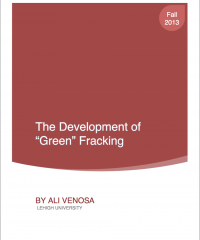Ali Venosa

Science and Environmental Writing 2015
Research Paper:
Paper Subheadings:

Introduction:
Hydraulic fracturing, the process of fracturing rocks with pressurized fluid to release natural gas, has become one of the most important and controversial technologies of the 21st century. Most of the controversy stems from the environmental impacts associated with fracking—mainly air and water pollution. Many question if the fracking industry is doing enough to address these issues, or if they’re even doing anything at all. Despite the deeply negative publicity fracking regularly receives, there have actually been many advancements in the area of “greener” fracking technologies.
The development of more environmentally friendly fracking techniques could be beneficial to the public, industry, and the environment. First, if fracking could be more environmentally friendly, it would eliminate the majority of political opposition to the practice. Since most of the dissent comes from those concerned with environmental and health impacts, lessening or eliminating these issues would remove the corresponding opposition. Less political friction would obviously be beneficial for the fracking industry, since it could continue more smoothly without protests and negative publicity.
A second reason the research and development of green fracking technologies would be beneficial is that it would reduce the threat of pollution, and consequently, climate change. Cleaning up fracking and reducing the amount of chemicals and gases the process releases into the water and air would actually benefit the public with a cleaner environment, which is a benefit regardless of political motivations. Lehigh students, many of whom come from areas in Pennsylvania affected by fracking, would definitely be affected positively if fracking adopted environmentally safer technologies.
A last reason for developing environmentally friendly technologies is that they are, when used correctly, more economical than the previous processes. Gas plants are cheaper than coal plants, and greener technologies, once implemented, are cheaper to operate than previous ones. By cleaning up the fracking process and lessening political opposition, the benefits of fracking are more likely to be achieved and noticed. The recent efforts made to come up with more environmentally friendly fracking technologies have produced a wide range of results. It’s undeniable that there has been progress in making fracking a cleaner method of natural gas extraction, but there are still questions that have yet to be answered about the future of this “greener” fracking dream. Are the technologies being developed legitimate? Can they be used universally to benefit all areas affected by fracking? Are all of the negative effects of fracking being addressed, or are there issues that are not being worked on? Lastly, do these advancements even matter? The burning of natural gas is cleaner than coal, but should our society really be spending time and money on a practice that is still going to release greenhouse gases and possibly accelerate global warming? There is evidence to support many opinions on this evolution of hydraulic fracturing technology.
The origins of fracking can be traced back to the 1940’s, but it was not used on a large commercial scale until 2003 (EEC, 2010). As fracking gained popularity and wells sprang up all across the United States, opposition to the practice started to become more and more prominent. Fracking became a word with a connotation of pollutants, health problems, and danger. To combat those opposed to fracking, companies began researching ways to make the practice safer and cleaner. These efforts have yielded multiple advancements that could very possibly eliminate the major environmental concerns surrounding the practice and change the fracking is done forever.
Halliburton Company, one of the world’s largest oilfield companies, has taken a lead on making technologies more environmentally friendly. One of its biggest—and most controversial—developments has been CleanStim, which is a fracking fluid supposedly formulated with ingredients from the food industry (Halliburton Co. 2013). Since the cocktail of chemicals in traditional fracking fluid has been the source of much unrest among fracking critics, a new, biodegradable alternative would be a huge step forward.
